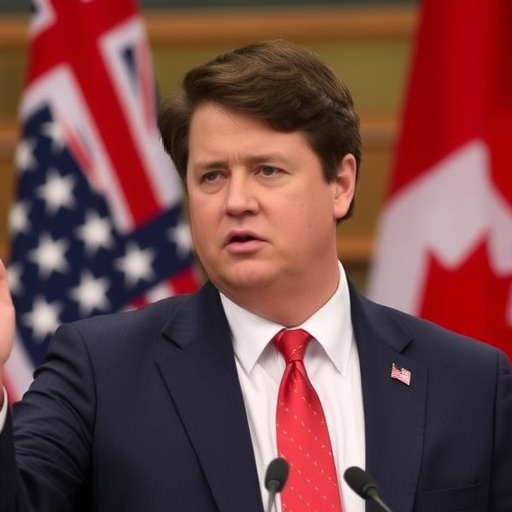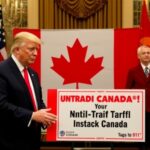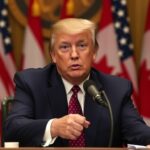Ontario Premier Doug Ford Backs Down on Anti-Tariff Ad as Trump Escalates Trade War Before ASEAN Summit
In a stunning reversal amid soaring international tensions, Ontario Premier Doug Ford announced on Wednesday that his government will immediately pull a controversial anti-tariff advertisement that had ignited a fierce backlash from U.S. President Donald Trump. The move comes just days after Trump doubled down on his threat to impose steep tariffs on Canadian goods, citing the ad as a direct provocation in the ongoing trade dispute. With both leaders set to cross paths at the upcoming ASEAN summit, the decision underscores the fragile state of U.S.-Canada relations and the high stakes for North American economies.
- Ford’s Ad Ignites Firestorm: From Provincial Protest to International Incident
- Trump’s Tariff Escalation: Hitting Ontario Where It Hurts Most
- Rising Stakes at the ASEAN Summit: Trump and Carney’s High-Noon Showdown
- Economic Repercussions for Ontario: Jobs, Industries, and Long-Term Strategies
- Path Forward: De-Escalation Hopes and the Road to Stable Trade
The ad, which aired across Ontario last week, depicted dramatic scenes of factory shutdowns and job losses, blaming Trump’s protectionist policies for threatening the province’s auto and manufacturing sectors. Titled “Don’t Let Tariffs Tank Our Economy,” it featured testimonials from workers in Windsor and Oshawa, two hotspots for automotive production. Ford’s office defended it initially as a necessary wake-up call, but Trump’s swift response—escalating tariffs on steel and aluminum imports from Canada to 25%—forced a quick about-face.
“We’ve heard the message loud and clear,” Ford said in a press conference from Queen’s Park. “This isn’t about picking fights; it’s about protecting Ontario jobs. We’re pulling the ad to de-escalate and focus on real solutions.” The premier’s comments reflect a pragmatic shift, as Ontario, Canada’s most populous province and a key exporter to the U.S., stands to lose billions if the trade spat intensifies.
Ford’s Ad Ignites Firestorm: From Provincial Protest to International Incident
The tariff ad first launched on October 15, strategically timed to coincide with U.S. midterm election discussions on trade. Produced by Ontario’s Ministry of Economic Development, it cost an estimated $2.5 million to create and air on TV, radio, and social media platforms. The 30-second spot opened with haunting imagery: empty assembly lines at Ford Motor Company’s plant in Oakville, overlaid with a voiceover stating, “President Trump’s tariffs could cost Ontario 50,000 jobs—don’t let it happen.”
Experts point to the ad’s bold rhetoric as the spark. “It crossed a line by personalizing the attack on Trump,” said Dr. Elena Vasquez, a trade policy analyst at the University of Toronto. “Previous Canadian responses to U.S. tariffs have been diplomatic; this felt like a direct jab.” Within hours of its debut, the ad went viral, amassing over 1.2 million views on YouTube and sparking heated debates on Twitter, where #TariffAd trended alongside #TrumpTradeWar.
Trump, never one to shy from social media skirmishes, fired back on Truth Social: “Canada’s Doug Ford thinks he can run ads smearing America? Wrong! Tariffs on their junk are going UP—effective immediately. Ontario pays the price for their insults.” This escalation wasn’t isolated; it built on Trump’s long-standing grievances with Canadian dairy subsidies and softwood lumber disputes, which have cost U.S. firms over $1 billion annually in retaliatory measures since 2018.
In Ontario, the ad’s reception was mixed. Supporters, including the Canadian Auto Workers union, praised it for highlighting real threats—Ontario exports $100 billion worth of goods to the U.S. yearly, with autos comprising 40%. Critics, however, accused Ford of grandstanding. “This was political theater at its worst,” remarked Conservative MP Lisa Raitt, a former transport minister. “It provoked Trump without a plan B.”
Trump’s Tariff Escalation: Hitting Ontario Where It Hurts Most
President Trump’s decision to hike tariffs represents a sharp intensification of the U.S.-Canada trade friction that has simmered since his first term. The new 25% levy on steel and aluminum—up from 10%—targets Ontario’s robust metals sector, which employs over 30,000 workers and contributes $15 billion to the provincial GDP. ArcelorMittal Dofasco, a major steel producer in Hamilton, warned that the increase could lead to immediate layoffs, with CEO Naveen Behal stating, “We’re already operating on thin margins; this could shutter plants overnight.”
Broader economic fallout looms large. According to a report from the Canadian Chamber of Commerce, a full-blown trade war could shave 2.5% off Canada’s GDP, with Ontario bearing the brunt due to its 40% share of national exports. Key industries at risk include not just metals but also agriculture—Ontario’s pork and dairy farmers already face U.S. barriers—and technology, where cross-border supply chains for firms like BlackBerry in Waterloo are vulnerable.
Trump’s rationale ties directly to the tariff ad, framing it as an unfair attack amid U.S. inflation pressures. “Canada’s been ripping us off for years,” he reiterated during a rally in Michigan, a swing state with deep ties to Ontario’s auto industry. “Ford’s ad is the last straw. Time for America First.” This echoes his 2018 imposition of tariffs under Section 232 of the Trade Expansion Act, which prompted Canada to retaliate with $12.6 billion in countermeasures on U.S. products like whiskey and ketchup.
Statistics underscore the asymmetry: The U.S. is Ontario’s largest trading partner, absorbing 75% of its exports, while Ontario represents just 5% of U.S. imports. Yet, Trump’s strategy leverages this imbalance, pressuring smaller players like Canada to concede. Economists like those at the Fraser Institute estimate that resolving the dispute could boost bilateral trade by $20 billion annually, but escalation risks a “lose-lose” scenario.
- Steel and Aluminum Impact: Ontario produces 60% of Canada’s steel; tariffs could raise U.S. prices by 15%, hurting downstream manufacturers.
- Auto Sector Ripple Effects: The Canada-U.S. auto corridor employs 500,000; disruptions could mirror the 2018 supply chain chaos, delaying 200,000 vehicles.
- Consumer Costs: Higher tariffs may increase prices for Ontario-sourced goods in the U.S., from beer to machinery, by 10-20%.
Rising Stakes at the ASEAN Summit: Trump and Carney’s High-Noon Showdown
As the dust settles on Ford’s ad withdrawal, all eyes turn to the ASEAN summit in Jakarta, scheduled for November 10-15, where U.S. President Trump and Canadian Prime Minister Mark Carney will both attend. The gathering, hosted by the Association of Southeast Asian Nations, focuses on regional trade pacts, but bilateral tensions between the North American leaders threaten to overshadow proceedings.
Carney, who assumed the premiership amid economic recovery efforts post-pandemic, has positioned himself as a staunch defender of free trade. In a recent interview with CBC, he vowed, “Canada won’t be bullied into unfair deals. At ASEAN, I’ll make it clear: tariffs hurt everyone, including American workers.” His attendance marks a diplomatic push to rally ASEAN nations—key players in global supply chains—against protectionism, potentially isolating Trump’s stance.
The summit provides a neutral stage for de-escalation. Past U.S.-Canada encounters at multilateral forums, like the 2019 G7 in Biarritz, have yielded breakthroughs, such as the USMCA trade agreement. However, insiders whisper of frosty preparations. A source close to Carney’s office revealed, “Trump’s team is demanding concessions on dairy access before any talks; it’s a non-starter for us.”
For Ontario, the implications are profound. Doug Ford has dispatched a trade delegation to Jakarta, emphasizing the province’s role in North American integration. “ASEAN is a chance to show the world Ontario’s open for business,” Ford noted, hinting at diversification efforts toward Asian markets. Indeed, Ontario’s exports to ASEAN grew 12% last year to $8 billion, offering a buffer against U.S. volatility.
Geopolitical angles add intrigue: Trump’s attendance aligns with his Indo-Pacific strategy to counter China, while Carney seeks to leverage ASEAN’s $3 trillion economy for Canadian gains. Analysts predict side meetings could broker a truce, but failure risks broader alliance strains, echoing the 1980s free trade negotiations that birthed NAFTA.
Economic Repercussions for Ontario: Jobs, Industries, and Long-Term Strategies
Beyond the headlines, Ford’s decision to yank the tariff ad exposes deeper vulnerabilities in Ontario’s economy. The province, with its 14.5 million residents and $800 billion GDP, thrives on U.S. interdependence—think seamless auto parts flowing from Detroit to Toronto. Yet, repeated tariff threats have prompted calls for resilience-building.
The Ontario Trillions Dollar Plan, Ford’s flagship economic blueprint, now faces headwinds. Aimed at creating 800,000 jobs by 2025, it hinges on manufacturing revival. Tariffs could derail this, with the auto sector alone projected to lose $5 billion in output. Union leader Jerry Diaz of Unifor warned, “Pulling the ad is a band-aid; we need federal action to safeguard supply chains.”
Provincial data paints a stark picture: Since Trump’s first tariff salvo in 2018, Ontario has seen 15,000 manufacturing jobs vanish, per Statistics Canada. Small businesses, like those in the GTA’s tech hub, report 20% higher input costs. To counter, Ford’s government is fast-tracking incentives, including a $500 million fund for export diversification and R&D in green tech—areas where ASEAN partnerships could shine.
Public sentiment in Ontario leans toward caution. A Leger poll conducted post-ad launch found 62% of residents support de-escalation, fearing inflation spikes—grocery prices already up 8% year-over-year. Environmental advocates, meanwhile, see opportunity: Tariffs might accelerate Ontario’s shift to EVs, with investments from Hyundai and GM totaling $10 billion.
- Immediate Job Protections: Ford pledged $100 million in retraining for affected workers.
- Trade Diversification: Targeting ASEAN for 20% export growth by 2026.
- Federal-Provincial Coordination: Carney’s team coordinating with provinces for unified ASEAN messaging.
Broader Canadian context reveals fractures: Quebec and Alberta, with their own U.S. export dependencies, have urged Ford’s restraint, while British Columbia pushes for WTO complaints against U.S. actions.
Path Forward: De-Escalation Hopes and the Road to Stable Trade
As Ontario navigates this trade tempest, the focus shifts to diplomatic off-ramps and economic safeguards. Ford’s ad pullout signals willingness to negotiate, potentially paving the way for bilateral talks post-ASEAN. Trump, facing domestic pressures from inflation-weary voters, may seek a win to tout before holidays.
Experts foresee a USMCA review clause activation in 2026 as a pressure valve, allowing tariff rollbacks tied to dispute resolution. For Carney at the summit, success means securing ASEAN endorsements for open markets, bolstering Canada’s position. Ontario businesses, from Sarnia refineries to Niagara wineries, await clarity—many are stockpiling inventory against further hikes.
Long-term, this episode highlights the perils of weaponized rhetoric in trade. “Ad wars won’t solve structural issues,” opined trade lawyer Michael Geist. “Canada needs to invest in alliances beyond the U.S.” Initiatives like the Canada-ASEAN Strategic Partnership, valued at $2 billion in new deals, offer promise. Ford, ever the dealmaker, teased provincial incentives for ASEAN investors, aiming to rebalance Ontario’s export ledger.
Ultimately, the tariff ad saga reminds us of trade’s human toll: families in Brampton fearing pink slips, entrepreneurs in London eyeing global pivots. As Trump and Carney converge in Jakarta, the world watches—will cooler heads prevail, or will protectionism’s shadow lengthen? Ontario, at the epicenter, braces for outcomes that could redefine its prosperity for years to come.









